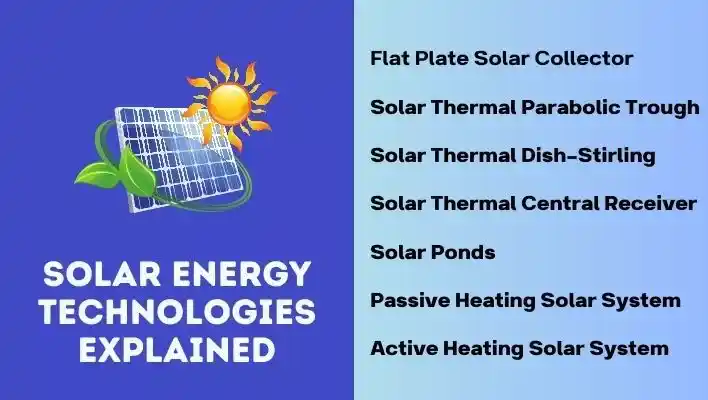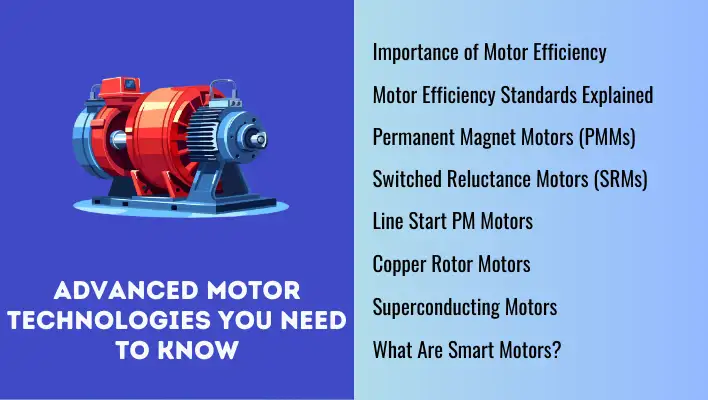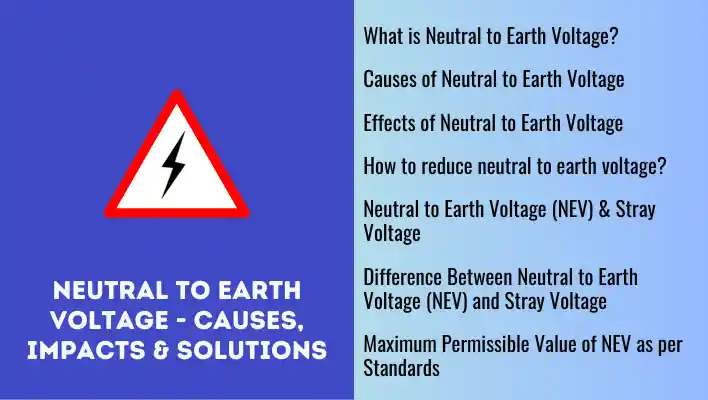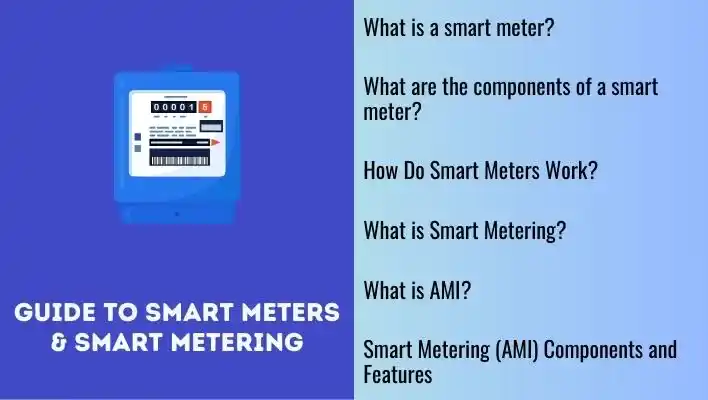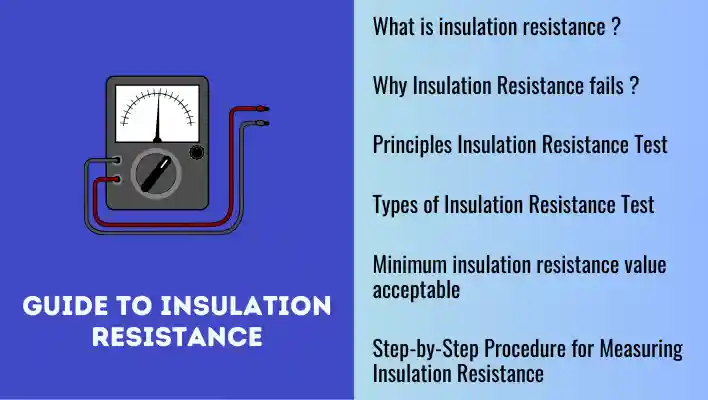Harnessing the power of the sun is becoming more important as we work towards a fossil fuel free future. The shining heavenly body up in the sky which we call Sun i.e. solar and solar energy technologies are leading this green movement, changing how we generate and use energy.
From solar panels on rooftops to solar water heaters, these technologies are helping us reduce our carbon footprint as well as save money on energy bills. In this blog post, we’ll look at the latest advancements in solar energy technologies, discussing their benefits, how they’re used, and what they mean for a cleaner, brighter future.
Importance of Sun in Renewable Energy technologies
In our previous article, we have explained Renewable Energy comprehensively and explained how Sun is the most valuable natural asset available for sustainable energy generation.
Renewable energy comes from various sources and factors like location, availability and technology all influence which one is best. Right now, the source Sun i.e. solar and solar technologies are the top choices because they are effective and widely used. The sun is always there, it’s free, and we won’t run out of it, making it a perfect energy source.
Interestingly, not only solar panels but many other renewable energies also rely on the sun. For example, wind is created when the sun heats the Earth’s atmosphere unevenly, causing air to move.
Plants use sunlight to grow, providing biomass energy, and the water cycle driven by the sun creates hydro-power.
Even geothermal energy, mostly from the Earth’s core, is partly influenced by the sun’s heat. Heat pumps use both the Earth’s and the sun’s warmth for heating and cooling.
Tidal energy, caused by the gravitational pull of the Earth, Moon, and Sun, uses ocean movements to generate power.
In short, solar and solar technologies are central to almost all renewable energy sources, showing just how important the sun is in our move towards sustainable energy.
Also Read: Renewable Energy | A comprehensive a Guide
Flat Plate Solar Collector

The flat plate solar collector is a simple and commonly used type of solar collector. It consists of a flat rectangular surface that acts as an absorber. This collector is quite efficient and convenient for heating temperatures up to 100°C.
Typically, it is installed on the roof of a building, a structure, or even in an open field. Flat Plate collectors can harness the power of both the strong, direct sunlight and the sunlight that is scattered by the atmosphere. This makes it a versatile and effective tool for heating purposes.
Working Principle of flat plate collector
- Solar Radiation Absorption: The flat-plate collector is positioned in such a way that it receives direct sunlight. The collector has a dark-colored absorber plate, usually made of metal, which absorbs sunlight and converts it into heat.
- Heat Transfer to the Absorber Plate: As the absorber plate absorbs sunlight, it heats up. The absorbed solar energy is then transferred to a fluid (typically water or a heat transfer fluid) that circulates through tubes or channels attached to the absorber plate.
- Fluid Circulation: The heated fluid circulates through the collector, absorbing the thermal energy from the absorber plate.
- Insulation: The back and sides of the flat-plate collector are insulated to minimize heat loss to the surroundings. This insulation helps direct the collected heat toward the intended application, such as heating water or space.
- Transparent Cover (Glazing): The collector is covered with a transparent material (glazing), often made of glass or transparent plastic. The glazing allows sunlight to pass through while trapping the absorbed heat, creating a greenhouse effect within the collector.
- Greenhouse Effect: The greenhouse effect helps maintain higher temperatures inside the collector by preventing the escape of the absorbed heat. The trapped heat raises the temperature of the fluid circulating through the collector.
- Heat Transfer to Application: The hot fluid is then directed to the application, such as a water storage tank for domestic hot water systems or a space heating system. The heat is transferred from the fluid to the target application, providing the desired thermal energy.
- Return of Cooled Fluid: After transferring heat to the application, the now-cooled fluid returns to the collector to repeat the cycle.
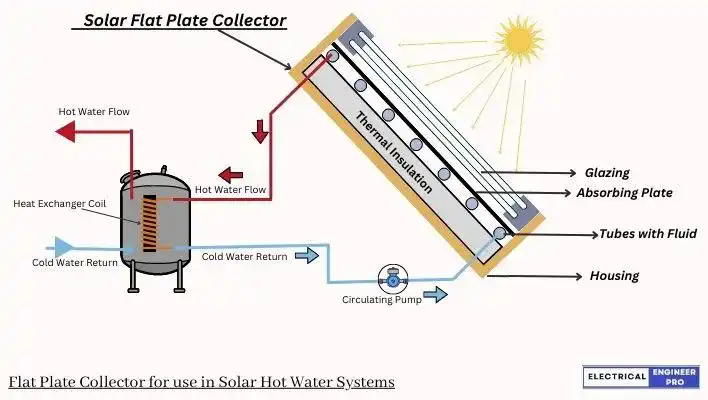
Components of flat plate collector
- Absorbing plate
The absorbing plate absorbs sunlight using a dark-colored, heat-absorbing material, converting solar energy into heat. This heat is efficiently transferred to a circulating fluid, such as water. The absorbing plate minimizes reflective losses, using treated surfaces, and is made of durable materials like copper or aluminum. Also It is compatible with the glazing material to optimize the greenhouse effect within the collector, ensuring effective solar thermal conversion for various applications.
- Glazing
The glazing in a flat-plate solar collector serves crucial functions: it traps and retains heat by allowing sunlight to enter while preventing heat escape, reduces heat loss to the environment, protects the absorber plate from environmental factors, allows visible light transmission for energy absorption, and enhances the collector’s durability.
- Tubes and passages
The tubes and passages in a flat-plate solar collector serve as conduits for the working fluid (usually water or a heat transfer fluid) to absorb the heat collected by the absorber plate.
- Insulation
Insulation is applied to the back and sides of the flat-plate collector to reduce heat loss to the surrounding environment. This is especially important during periods of low solar radiation or at night when the collector is not actively receiving sunlight.
- Housing
The housing provides a structural framework for supporting and securing the various components of the flat-plate collector, including the absorber plate, tubes, glazing, and insulation. It ensures the stability and integrity of the collector structure, especially in outdoor environments exposed to weather conditions.
Types of flat plate solar collector
In flat plate collectors, there are two different variations based on the working medium. These collectors can be classified into two types, depending on the type of heat transfer fluid they use.
- Liquid Heating Collectors.
- Air or gas heating collectors.
Applications of flat plate solar collector
Flat plate collectors have various applications, including:
Water Heating: They are commonly used to heat water for domestic, swimming pool, and industrial purposes. These collectors absorb solar energy and transfer it to the water flowing through them, effectively increasing its temperature.
Space Heating: Flat plate collectors can be employed to provide heat for space heating systems in buildings. By capturing solar energy, they convert it into heat that can be distributed throughout the building via a central heating system.
Solar Air Conditioning: In certain solar air conditioning systems, flat plate collectors are used to generate thermal energy. This energy is then used to power absorption chillers or desiccant cooling systems, which help cool the air in buildings using solar energy.
Solar Drying: Flat plate collectors find applications in solar drying systems used for agricultural products, food processing, and industrial drying. These collectors capture solar energy and utilize it to heat the air, facilitating the drying process.
Solar Cooking: Flat plate collectors can also be used in solar cookers or ovens. They concentrate and capture sunlight, converting it into heat for cooking food. This environmentally friendly method reduces the reliance on traditional cooking fuels.
These are just a few examples of how flat plate collectors can be utilized across various sectors to harness solar energy for different purposes.
Solar Thermal Parabolic Trough

Solar parabolic trough collectors are a type of concentrating solar power (CSP) technology used to harness solar energy for electricity generation. It uses curved mirrors that look like a long, shallow trough to collect and focus sunlight. The mirrors are shaped this way to make the sunlight more intense at one point.
The sunlight is focused onto a tube placed along the trough’s middle line. Inside the tube, there is a fluid, like oil or salt, that gets very hot when it absorbs the concentrated sunlight.
The hot fluid is then used to make steam. This steam can be used to turn a turbine and generate electricity. Or it can be used directly for things like heating water or powering industrial processes.
To keep everything working smoothly, the trough follows the movement of the sun throughout the day. This ensures that the sunlight is always concentrated onto the tube.
Components and Working of solar parabolic trough collector
The working principle of solar parabolic trough collectors involves concentrating sunlight onto a receiver tube positioned along the focal line of each parabolic trough. Here is a step-by-step explanation of how solar parabolic trough collectors operate:
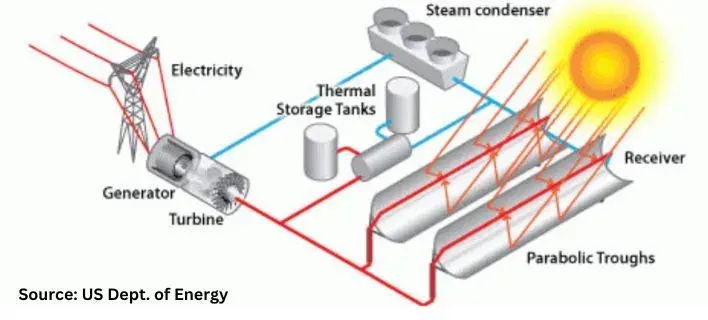
- Parabolic Trough: The collector consists of long, parabolic-shaped mirrors arranged in rows. These mirrors track the sun’s movement throughout the day to maximize sunlight capture.
- Sunlight Concentration: The parabolic shape of the troughs allows them to concentrate sunlight onto a single focal line. The mirrors are coated with a highly reflective material to enhance the concentration of sunlight.
- Receiver Tube: A receiver tube, containing a heat transfer fluid (HTF), is positioned along the focal line of each parabolic trough. The HTF is often a synthetic oil or molten salt.
- Solar Energy Absorption: Sunlight is concentrated by the parabolic troughs onto the receiver tubes. The concentrated sunlight heats the HTF within the receiver tube.
- Circulation of Heat Transfer Fluid: The heated HTF circulates through the receiver tubes and absorbs the concentrated solar energy. The fluid’s temperature increases significantly during this process.
- Heat Exchange: The heated HTF then passes through a heat exchanger where it transfers its thermal energy to a working fluid, typically water. This heat exchange results in the vaporization of the working fluid, producing high-pressure steam.
- Electricity Generation: The high-pressure steam is used to drive a turbine connected to an electricity generator. As the turbine rotates, it generates electrical power.
- Sun Tracking System: To maintain optimal sunlight concentration, parabolic trough collectors use sun-tracking systems. These systems continuously adjust the position of the mirrors to track the sun’s movement across the sky.
- Optional Thermal Storage: Some parabolic trough power plants incorporate thermal energy storage systems. Excess heat generated during periods of high solar radiation can be stored for later use, enabling power generation during cloudy periods or at night.
- Power Plant Configuration: Multiple parabolic trough collectors are typically arranged in parallel to form a solar field. The collected thermal energy is then transferred to a central power block for electricity generation.
Applications of Solar parabolic trough
Solar parabolic trough collectors are versatile and find applications in various fields due to their ability to generate high-temperature heat. Some of the primary applications include:
- Electricity Generation: Solar parabolic trough collectors are commonly used in utility-scale solar thermal power plants. The concentrated sunlight is used to generate high-pressure steam, which drives turbines connected to generators to produce electricity.
- Desalination:Solar thermal energy from parabolic trough collectors can be utilized in desalination processes to produce fresh water from seawater.
- District Heating: Solar parabolic trough systems can contribute to district heating applications, providing hot water for residential and commercial heating needs in local communities.
- Hybrid Systems with Fossil Fuels: Parabolic trough collectors can be integrated into hybrid systems with fossil fuel power plants. This integration allows for the use of solar energy to supplement conventional power generation.
- Space Heating: Solar trough collectors can be used for space heating in residential, commercial, or agricultural settings.
- Steam Generation for Industrial Processes: Industries requiring steam for various processes, such as food processing, textiles, or chemical manufacturing, can use solar parabolic trough collectors to generate steam, reducing the reliance on fossil fuels.
- Remote Power Generation: Solar parabolic trough systems can be deployed in remote areas where access to conventional power sources is limited.
The applications of solar parabolic trough collectors highlight their flexibility in delivering high-temperature heat for diverse purposes, contributing t
Solar Thermal Dish-Stirling

Solar Thermal Dish-Stirling systems is a kind of concentrating solar power (CSP) technology, known for its high efficiency and potential for decentralized power generation. It is suitable for both grid-connected applications and off-grid installations, making it a promising technology for regions with high solar radiation.
These systems use sunlight to create electricity. They work by turning the heat from the sun into mechanical energy and then that mechanical energy is turned into electrical energy.
Also these systems are quite efficient because they can convert almost 30% of the sun’s energy into electricity.
Components of Solar Thermal Dish-Stirling
The solar thermal dish-Stirling system consists of several key components that work together to convert solar energy into electricity using a Stirling engine. Here are the main components and the working principle of a solar thermal dish-Stirling system:
- Parabolic Dish Reflector: The parabolic dish reflector is a large, curved mirror that concentrates sunlight onto a specific focal point. It is mounted on a two-axis tracking system to follow the sun’s movement.
- Receiver Module: Positioned at the focal point of the dish, the receiver module contains the Stirling engine and a heat exchanger. The Stirling engine and heat exchanger work together to convert solar thermal energy into mechanical energy.
- Stirling Engine: The Stirling engine is an external combustion engine that operates on the principle of a closed thermodynamic cycle. It typically consists of a piston or displacer, a re-generator, and a heat exchanger.
- Heat Exchanger: The heat exchanger is a crucial component that transfers thermal energy from the concentrated sunlight to the working fluid (usually helium or hydrogen) in the Stirling engine.
- Working Fluid: The working fluid circulates within the Stirling engine, undergoing cyclic compression and expansion phases. It absorbs heat in the heat exchanger and releases heat during the expansion phase.
- Generator: The mechanical energy produced by the Stirling engine is used to drive a generator, converting it into electrical energy. The generator is responsible for producing the electricity that can be utilized or fed into the grid.
- Sun Tracking System: The solar dish is equipped with a sun-tracking system that adjusts the position of the dish to keep it pointed directly at the sun. This ensures maximum solar concentration throughout the day.
Working Principle of Solar Thermal Dish-Stirling
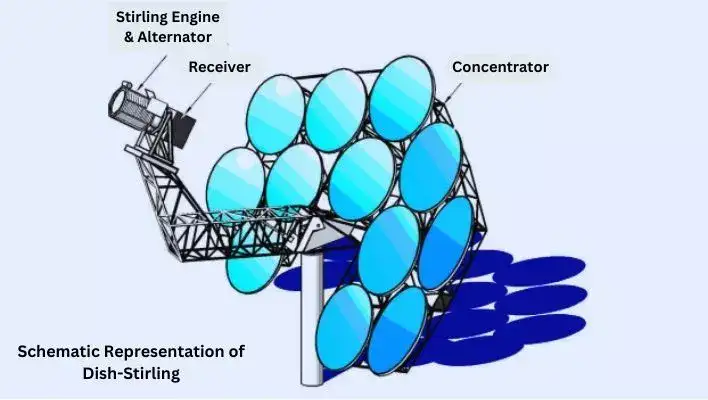
- The parabolic dish reflector concentrates sunlight onto the receiver module at the focal point.
- The concentrated sunlight heats the working fluid (helium or hydrogen) in the Stirling engine’s heat exchanger. This increases the temperature of the working fluid.
- The heated working fluid flows through the Stirling engine, where it undergoes cyclic compression and expansion phases. The expansion phase generates mechanical energy.
- The mechanical energy produced by the Stirling engine is then used to drive a generator, converting it into electrical energy.
- The generated electricity can be used immediately or fed into the electrical grid for distribution.
- The sun-tracking system continuously adjusts the position of the parabolic dish to maintain optimal solar concentration as the sun moves across the sky.
Applications of Solar Thermal Dish-Stirling
- Dish/engine systems can produce different amounts of power, from small to very big. But they are expected to have the most impact when connected to the power grid and generate electricity in the range of 1 to 50 megawatts. This means they can supply a good amount of electricity to homes and businesses.
- Additionally, dish/engine systems can be utilized as standalone systems for specific purposes such as water pumping. They can provide reliable and sustainable power to operate water pumps, ensuring a consistent water supply for various applications.
- Dish Stirling systems can be integrated with other renewable energy sources such as wind or solar PV to create hybrid power systems. This integration enhances overall system efficiency and ensures a continuous power supply even during periods of low solar radiation.
Solar Thermal Central Receiver
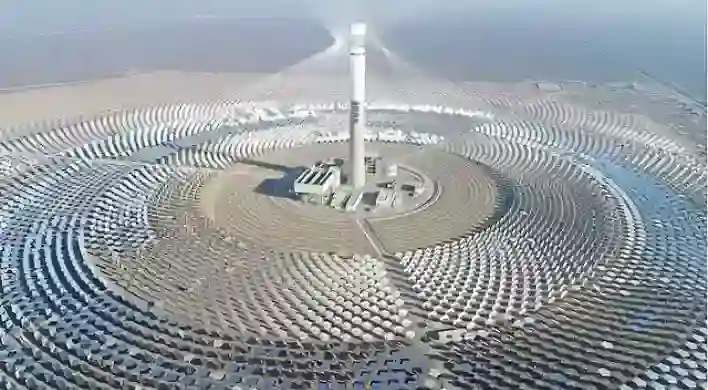
A Central Receiver Solar Thermal Power Plant, also called a solar power tower, is a type of solar power plant that uses sunlight to generate electricity, just like other solar power plants.
These power plants can produce a lot of electricity, making them great for large-scale use by utilities. One advantage they have is the ability to store thermal energy. This means they can keep producing electricity even when the sun is not shining, making them a dependable and Eco-friendly source of power.
Components and Working Solar Thermal Central Receiver
The major components of central receiver power system are,
- Heliostat: A heliostat is a device that looks like a mirror and is used to reflect sunlight onto the tower/receiver. Heliostats can be placed on one side of the receiver or in a circle around it. They are usually attached to a support structure and can move to follow the sun as it moves across the sky. By adjusting their positions, heliostats make sure that the sunlight is accurately directed towards the tower/receiver.
- Tower/Receiver: The tower/receiver is the central component of a Central Receiver Power System. It is usually a tall structure located at the center of the solar power plant. The tower/receiver absorbs the concentrated sunlight from the heliostats. This intense heat is used to heat up a working fluid or material.
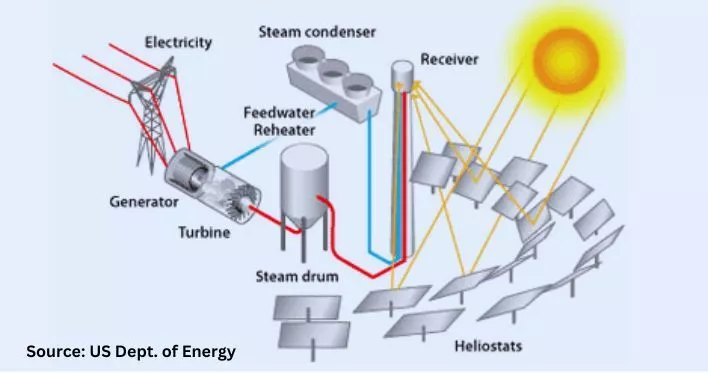
- Working Fluid: The working fluid is a substance that is heated by the concentrated sunlight in the tower/receiver. It can be in the form of a gas, such as air, or a liquid, such as molten salt. The purpose of the working fluid is to absorb the thermal energy from the concentrated sunlight and carry it to the next stage of the system.
- Storage Tanks: Storage tanks are used in some Central Receiver Power Systems to store the thermal energy generated by the working fluid. The heated working fluid can be stored in tanks during the day when the sunlight is abundant. Later, when the demand for electricity is high or when the sun is not shining, the stored thermal energy can be used to generate electricity continuously.
- Generator: The generator is the component that converts the thermal energy into electrical energy. The heated working fluid is used to generate steam, which drives a turbine connected to a generator. As the turbine spins, it generates electricity. This electrical energy can then be transmitted and used for various applications, such as powering homes, businesses, or industries.
These components work together in a Central Receiver Power System to harness solar energy, convert it into thermal energy, and finally into electrical energy, providing a sustainable and renewable source of power.
Applications Solar Thermal Central Receiver
- Utility-Scale Power Generation: These power plants are capable of generating a large amount of electricity and can provide clean and sustainable energy to meet the electricity demands of cities, towns, and industrial areas.
- Grid Integration: Central Receiver Solar Thermal Power Plants can be integrated into existing power grids, supplying renewable energy to the grid and reducing the reliance on fossil fuel-based power generation.
- Remote Areas: These power plants can be deployed in remote areas where access to electricity is limited or non-existent. They offer a viable solution to provide electricity to off-grid communities, enabling economic development, improved living conditions, and access to essential services like healthcare and education.
- Industrial Processes: The heat generated can be utilized in applications such as steam production, desalination, chemical production, and manufacturing, reducing the reliance on fossil fuel-based heat sources.
- Renewable Heat Applications: The thermal energy produced by these power plants can be used for district heating systems, where it is distributed to residential, commercial, and institutional buildings for space heating and hot water purposes.
- Energy Storage: Central Receiver Solar Thermal Power Plants store extra thermal energy when there is a lot of sunlight available. Later, when there is less sunlight, the stored energy can be used to produce electricity. This helps to ensure a steady and uninterrupted power supply, even when the sun is not shining brightly.
Solar Ponds
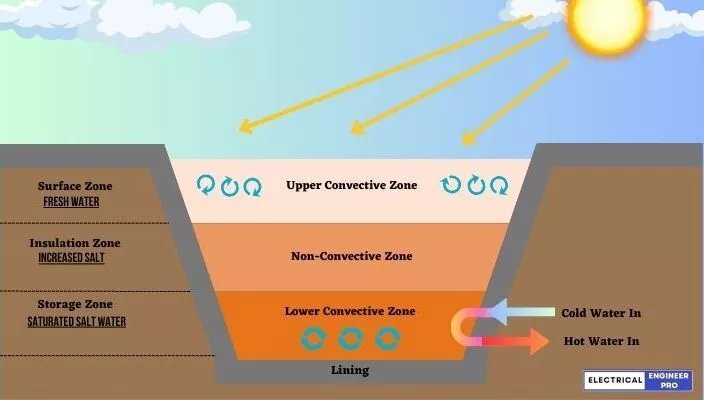
A solar pond is a special type of pond that collects solar energy and stores it as heat for practical use. It can come in different designs, such as saltwater ponds, gel ponds, or shallow ponds with covers. The main purpose of a solar pond is to store the energy from sunlight in the heated depths of the pond and prevent heat loss to the surroundings.
Solar ponds work by absorbing sunlight and converting it into heat energy. This energy is then stored in the deeper parts of the pond. The design of the pond helps to suppress convection currents, which are movements of heat that can cause heat loss. By preventing these currents, the pond can retain and store the heat for longer periods.
Basic Principle of Solar Pond
In a natural pond, approximately 30% of the sunlight reaches a depth of 2 meters. This sunlight is absorbed by the bottom of the pond, causing the water there to become hotter.
As a result, the hot water becomes lighter and rises to the surface. At the surface, the water loses heat to the surrounding air, which prevents the pond from getting much hotter than the surrounding environment.
To create a temperature difference between the upper and lower layers of the pond, a mechanism is implemented to prevent mixing between them. There are several ways to achieve this.
The simplest method is to make the lower layer denser than the upper layer by adding salt to the lower layers. Sodium chloride or magnesium chloride are commonly used salts because they are inexpensive.
By making the lower layer denser through salt addition, the upper and lower layers of the pond remain separated, and the lower layers can achieve higher temperatures compared to the upper layers. This design allows for the efficient collection and storage of solar heat in the lower layers of the pond.
Electricity generation from Solar Ponds
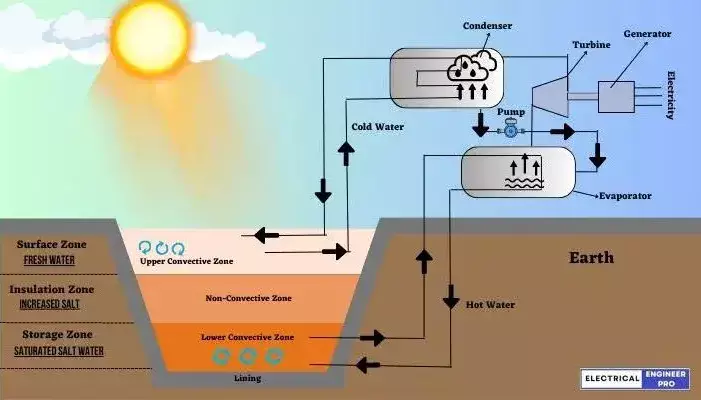
Solar ponds utilize organic Rankine cycle engine systems for electricity generation. Additionally, thermoelectric devices can be integrated with solar ponds to convert low-grade heat into electricity, offering a potential solution for certain applications.
One notable advantage of solar pond electric generation is its ability to provide electricity on demand. This is due to the inherent storage capability of solar ponds, allowing for continuous and reliable power availability, unlike other solar-electric systems that may have intermittent generation.
Overall, while the efficiency of converting sunlight to electricity is modest, solar ponds with organic Rankine cycle engines or thermoelectric devices can still offer a cost-effective and dependable means of generating electric power.
Applications of solar ponds
- Salt Production: Solar ponds can be used to enhance evaporation or purify salt, enabling the production of high-quality salt through natural processes.
- Aquaculture: Solar ponds can support the growth of aquatic organisms, such as fish or brine shrimp, by providing an environment with controlled saline or freshwater conditions.
- Dairy Industry: Solar ponds can be employed in the dairy industry to preheat feed water for boilers, helping to improve energy efficiency and reduce heating costs.
- Fruit and Vegetable Canning Industry: Solar ponds can contribute to the fruit and vegetable canning process by providing thermal energy for sterilization or pasteurization purposes.
- Fruit and Vegetable Drying: Solar ponds can be utilized for drying fruits and vegetables, particularly vine fruits, by harnessing the sun’s heat to remove moisture and preserve the produce.
- Grain Industry: Solar ponds can aid in the drying of grains, helping to reduce moisture content and prevent spoilage, thus maintaining the quality and longevity of the harvested grains.
- Water Supply: Solar ponds can play a role in water supply systems, particularly in desalination processes, where they provide a source of heat for converting saltwater into freshwater for various uses.
Passive Heating Solar System
Passive solar heating is a way to use the sun’s heat to warm buildings without using machines or electricity. It involves designing buildings to capture and store the sun’s heat, so it can be used to keep the inside warm.
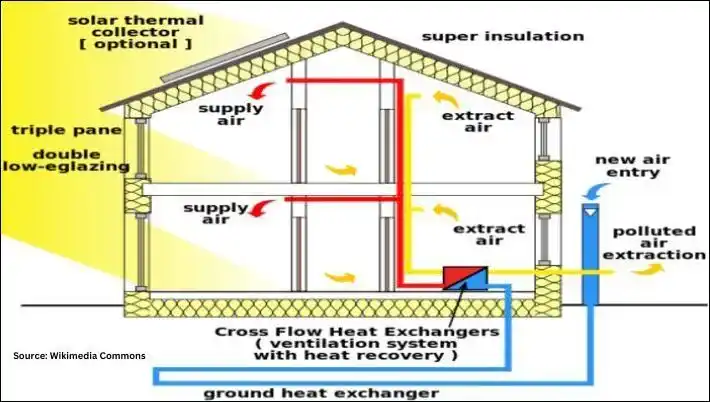
Working of Passive Heating Solar System
Here’s how it works:
Building Placement: The building is positioned to face the sun, so it can get the most sunlight during the colder months.
Windows: Large windows are put on the side of the building that faces the sun. These windows let the sunlight come in and warm up the inside. They are also insulated to keep the heat inside when it’s cold outside.
Heat Storage: Special materials, like concrete or stone, are used in the building’s structure. These materials absorb the heat from the sunlight and store it. When it gets cooler at night, they release the stored heat, keeping the inside warm.
Insulation: The building is insulated well to prevent heat from escaping through the walls, roof, and floor. This helps to keep the warmth inside the building.
Natural Ventilation: The building is designed with openings like windows or vents that can be used to let fresh air in or out. This helps to control the temperature and prevent the building from getting too hot.
By using these strategies, passive solar heating can keep buildings warm without using a lot of energy. It’s especially useful in sunny areas and can be used in different kinds of buildings like houses, offices, and stores.
Active Heating Solar Systems
Active solar heating is a popular method for using solar energy in homes. It involves collecting heat from the sun and using it to heat water and spaces inside the house. The system is called “active” because it uses pumps and fans to move the captured heat to where it is needed.
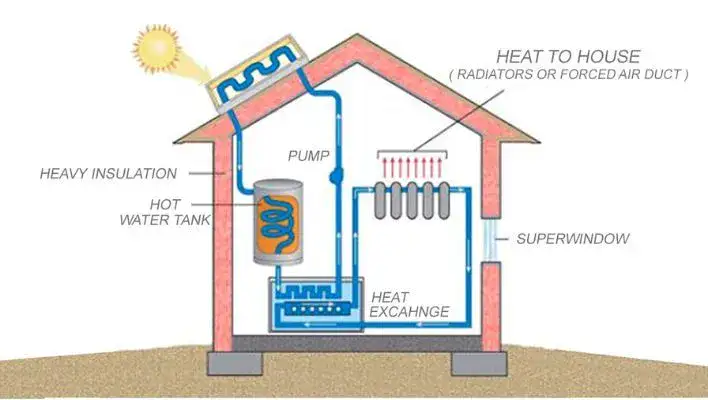
Working of Active Heating Solar Systems
Here’s how it works:
Collectors: Special panels, called collectors, are installed on the roof or in an open area where they can absorb sunlight. These collectors contain tubes or plates that capture the heat from the sun.
Collector Controls: The collectors are connected to controls that monitor the temperature and control the flow of heat. These controls ensure that the system operates efficiently and that the heat is transferred effectively.
Heat Storage System: The captured heat is transferred to a storage system, usually a large tank or thermal mass, where it is stored for later use. This stored heat can be used to heat water or circulate through pipes to provide warmth in the house.
Distribution System: The heat from the storage system is distributed to different areas of the house through pipes, radiators, or underfloor heating. This allows the heat to reach the desired spaces and provide warmth for domestic use or space heating.
Active solar heating systems are an effective way to harness solar energy for heating purposes. They are commonly used to heat water for showers, baths, and household activities. Additionally, they can provide heat to warm the living spaces in a home. By using pumps and fans, the captured solar heat is efficiently transferred and utilized to create a comfortable living environment while reducing reliance on traditional heating methods.
Applications of Active Heating Solar Systems
An active solar energy system can be used for various purposes, including:
- Heating water for domestic use, such as bathing or washing.
- Providing heat for recreational or therapeutic purposes, like swimming pools or hot tubs.
- Space conditioning, which means using solar energy to heat or cool the indoor spaces in a building.
- Generating electricity by converting solar energy into electrical power.
- Supplying heat for industrial processes, such as manufacturing or drying.
- Harnessing solar energy to power mechanical systems, such as pumps or fans.
By utilizing an active solar energy system, these different applications can benefit from the abundant and renewable energy provided by the sun. It offers a sustainable and environmentally friendly solution for meeting various energy needs.
summary
The sun can power an abundant array of renewable technologies to satisfy a wide range of energy needs. The most common types of solar technologies presented were PV solar flat-plate, Solar thermal parabolic troughs, Dish/Stirling, Thermal central receiver, Solar ponds, Active and Passive technologies.
These technologies can be used in applications such as water heating, space heating and cooling, refrigeration, industrial process heat, desalination, thermal power systems, solar furnaces and chemistry applications.
Also to be noted here is that solar energy technologies are not limited and there may be many other technologies which are not described here either because they are not fully developed or are not matured yet.
References
- https://www.energy.gov/eere/solar/how-does-solar-work
- https://www.nrel.gov/research/re-solar.html
- https://www.eia.gov/kids/energy-sources/solar/
- https://www.irena.org/Energy-Transition/Technology/Solar-energy
- https://www.energy.gov/eere/solar/power-tower-system-concentrating-solar-thermal-power-basics
- https://www.energy.gov/eere/solar/concentrating-solar-thermal-power-basics
- https://www.energy.gov/eere/solar/dishengine-system-concentrating-solar-thermal-power-basics
- https://www.nrel.gov/research/re-passive solar.html

